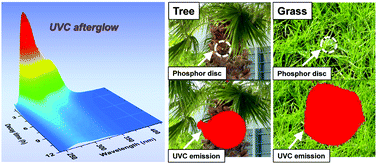Ultraviolet-C persistent luminescence from the Lu2SiO5:Pr3+ persistent phosphor for solar-blind optical tagging†
Abstract
Visible and infrared persistent phosphors have gained considerable attention in recent years and are being widely used as glow-in-the-dark materials in dark environments. In contrast, the progress in persistent phosphors emitting at the other end of the spectrum, i.e., the shorter-wavelength ultraviolet-C (UVC; 200–280 nm), is rather slow. Here we report the design and synthesis of a well-performing Pr3+-doped UVC emissive persistent phosphor, Lu2SiO5:Pr3+, which exhibits intense UVC persistent luminescence peaking at 270 nm and a long persistence time of more than 12 h after excitation with a 254 nm UV lamp. Besides, the UVC persistent luminescence of a UV pre-irradiated sample can be repeatedly revived after repeated short-illumination with low-energy white light via a process called photostimulated persistent luminescence. Owing to the distinct spectral features of UVC light and the self-sustained luminescence properties, the UVC persistent luminescence of the Lu2SiO5:Pr3+ persistent phosphor can be clearly monitored and imaged using a corona camera in bright environments including direct sunlight and indoor light. The Lu2SiO5:Pr3+ persistent phosphor is expected to find promising applications in the covert optical tagging field.



 Please wait while we load your content...
Please wait while we load your content...